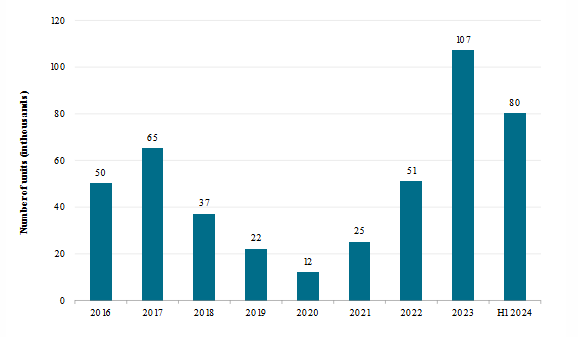Demand for residential real estate in Dubai has increased significantly since 2022. Given the significant rise in the number of new residential launches over the past two years, we previously expected prices would stabilize and demand would abate by year-end 2024. This has not been the case.
Based on Reidin’s “Dubai & Abu Dhabi Real Estate Market Overview Q2 2024” report, the pace of new launches in first-half 2024 was higher than in 2023( see chart 1). Off-plan sales amounted to $34.3 billion in first-half 2024, on track to exceed $58.3 billion in full-year 2023. So far, the escalation of geopolitical conflicts in the Middle East has had no significant effects on Dubai’s residential real estate market.
Chart 1
Frequently Asked Questions
What are the key reasons for the strong performance of Dubai’s real estate market this year?
Dubai’s real estate sector benefits from demand from local and international investors. Dubai’s resident population–which excludes the number of workers commuting to Dubai–increased to 3.7 million at year-end 2023, according to the Dubai Statistics Center. We project that it will reach 4.0 million by 2026 on the back of an increasing number of expatriates. Rising rents meant that many residents decided to buy instead of continuing to rent.
Several visa reforms, including to the Golden Visa, provided stability to residents and attracted wealthy international investors. Given our expectation of population growth, high prevailing rents, and the high value per square foot (sq.ft.), returns on real estate investments in Dubai exceed those in most European countries. Therefore, off-plan sale transactions (primary market) are twice as high in first-half 2024 as the secondary market and buyers are willing to pay a higher price per sq.ft. for new constructions.
Chart 2
We expect Dubai’s economy will remain relatively resilient. Despite geopolitical tensions in the region, we assume a protracted, direct Israel/U.S.-Iran conflict will not emerge. We expect that real GDP growth will remain close to 3.0% on average over 2024-2027, following a growth of 3.3% in 2023, and that Dubai’s GDP per capita will be about $38,000 in 2024.
The government’s economic agenda, D33, aims to attract more investments in real estate. It focuses on transparency and technological advancements for Dubai’s real estate market. Its goals are to increase real estate transactions by 70%, and multiply the value of Dubai’s real estate portfolios by 20 to UAE dirham (AED) 20 billion. Dubai’s Real Estate Strategy 2033 aims to contribute AED73 billion to the emirate’s GDP and to raise home ownership rates to 33% in 2033. Such initiatives, alongside investment reforms and supportive regulations for businesses, boost Dubai’s real estate market. Dubai’s dynamic economic environment, its reputation as a safe haven, and the low tax regime sustain the emirate’s attractiveness for global investors.
What are your expectations for Dubai’s real estate residential market over 2025-2026?
Property prices will remain stable over the next 18 months and could decline afterward due to increasing supply. A potential increase in supply could saturate the unfulfilled demand, and lead to lower prices and rents. The market expects residential supply stock will increase by about 182,000 units over 2025-2026, given that the large number of properties that were presold over 2022-2023 will be delivered. This is significantly higher than the average of 40,000 units delivered per year over 2019-2023 (see chart 3). However, the real estate inventory absorption rate, among others, depends on the annual growth of Dubai’s population–which we expect will be about 3.5% over 2025-2026–and investor demand. So far though, deliveries in 2024 have not kept pace with those in 2023 (see chart 3.) Significant delays in delivery, which are not uncommon for the industry–often due to construction capacity constraints–could tighten the market and support upward price trends, at least over the short term. Yet we expect the residential real estate market will balance out by 2026 at the latest.
Chart 3
Sales prices per sq.ft. in the primary market will remain stable in 2025, after having stabilized since fourth-quarter 2023. This is because we believe developers will focus more on increasing sales volumes rather than price growth. However, prices for ready properties could slightly increase due to their availability, better affordability compared with the primary market, and the still high demand. Rental growth will stabilize as the stock of available units increases. The stabilization will first materialize in non-prime areas and could spread to the wider market afterward.
The pace of new launches will decrease over the next 12-24 months. The level of launches the market has been able to absorb so far in this cycle does not seem sustainable over the long run. While developers are in a sound financial position, given strong cash collection, we expect they will remain agile in adjusting new project launches to demand evolution, that is, selling smaller units when prices are increasing. In a weaker environment, we expect less established developers will start to ease payment plans to maintain sales figures.
The share of luxury developments will reduce in 2025 since developers will continue to focus on affordable and mid-market properties. Even though luxury developments generate a higher margin, the market for luxury apartments remains relatively small in comparison. We believe developers will adjust the property mix and size to offer more affordable apartments and villas.
Developers with limited track record of operating in Dubai’s volatile real estate market will struggle with working capital outflows and low cash flows when the cycle turns. Dubai’s real estate market has become increasingly competitive, with many new developers entering the market. A slowdown will affect them first because they operate on lower margins and have less negotiating power.
What are key performance risks of Dubai’s real estate market over the next 12-18 months?
The escalation of the conflict in the Middle East constitutes the main risk. We assess regional stress levels as moderate, with elements of high stress potentially developing. Historically, the UAE–including Dubai–benefited from regional conflicts as they are considered a safe haven. This led to population growth and investment inflows. The current conflict, however, is more complex than previous ones, in our view. We consider it is unpredictable and likely to persist well into 2025, with potentially lasting effects. Economic disruption could affect capital flows, tourism, and even population growth since expatriates still account for a large portion of the UAE’s population.
Dubai’s residential market remains undeterred by local inflation and high interest rates since most transactions are not funded by mortgages. High sensitivity to interest rates in Dubai does not exist, given mortgages are available primarily for secondary market transactions or at handover of primary sales. Despite the high interest rates–which are projected to decrease slowly–we have seen growth in mortgage transactions over the past year as the volume of transactions increased significantly. Lower interest rates will sustain growth in mortgage transactions. Consumer price inflation in Dubai rose to 3.38% as of August 2024, mainly due to domestic factors, such as higher education fees, insurance fees, and house rentals. We expect it will remain above 3% in 2024. That said, global pressures, including declining oil prices, will not leave Dubai unaffected.
How resilient are residential developers in Dubai?
We expect our ratings on developers will remain resilient in a weaker market environment due to reduced leverage, strong cash flow generation, and good liquidity buffers. We rate three developers that are highly exposed to Dubai’s real estate market (see table 1). Together, Emaar Properties PJSC (Emaar Properties, BBB/Stable/–), Damac Real Estate Development Ltd. (Damac, BB/Stable/–), and PNC Investments LLC (Sobha, BB/Stable/–) hold 35%-40% of Dubai’s off-plan market share. The three developers benefit from good revenue visibility over the next two years, thanks to their robust revenue backlogs after strong presales over 2023-2024. We therefore upgraded our ratings on Damac and Sobha to ‘BB/Stable/–‘ from ‘BB-/Positive/–‘ earlier in 2024. The rating on Emaar Properties is now higher at ‘BBB/Stable/–‘, compared with ‘BBB-/Stable/–‘ before the COVID-19 pandemic in January 2020 as the company was able to capture a large share of renewed demand and improve its credit ratios in the upcycle.
Table 1
| Rated developers with significant exposure to Dubai’s residential real estate market | ||||||||||||
|---|---|---|---|---|---|---|---|---|---|---|---|---|
| –Fiscal year ends Dec. 31– | ||||||||||||
| Long-term issuer credit rating | Outlook threshold (downside) | Actual rolling 12 months ended June 2024 | 2024e | 2025f | ||||||||
Emaar Properties PJSC | BBB/Stable/– | |||||||||||
| Debt to EBITDA (x) | Exceeds 1.5 | Net cash | 0.0-0.5 | 0.0-0.5 | ||||||||
| FFO to debt (%) | Below 60 | Net cash | Above 100 | Above 100 | ||||||||
| EBITDA interest coverage (x) | Below 10 | 21.5 | 18.5-19.5 | 22.3-22.8 | ||||||||
Damac Real Estate Development Ltd. | BB/Stable/– | |||||||||||
| Debt to EBITDA (x) | Exceeds 1.5 | 1.2 | 0.9-1.2 | 0.8-1.0 | ||||||||
| EBITDA interest coverage (x) | N/A | 10.8 | 14.0-16.0 | 15.0-16.0 | ||||||||
PNC Investments LLC | BB/Stable/– | |||||||||||
| Debt to EBITDA (x) | Exceeds 1.5 | 2.3 | 1.3-1.5 | 0.5-1.0 | ||||||||
| EBITDA interest coverage (x) | N/A | 5.9 | 5.0-10.0 | 15.0-20.0 | ||||||||
| All figures are adjusted by S&P Global Ratings. e–Estimate. f–Forecast. N/A–Not applicable. Source: S&P Global Ratings. | ||||||||||||
We do not believe that the high presale levels in 2024, which are expected to exceed the peak in 2023, will be sustainable over 2025-2026 (see chart 4). Nevertheless, the nature of presales, whose payment plans accelerate, ensures that developers’ cash flows are sufficient to meet their commitments and invest in land plots. That said, cash flow generation in first-half 2024 was lower for most of our rated developers, given high development construction activity, modest capital expenditure on building rental portfolios, and landbank investments. We are also observing high dividend payouts in 2024.
Chart 4
After the merger of Nakheel and Meydan with Dubai Holding in March 2024, a single entity now owns a significant portion of land in Dubai. We expect the companies will align their strategies as they play a key role in supporting Dubai’s dynamic real estate market. The sustainability of the market for private developers depends on the availability of attractively priced land.
No content (including ratings, credit-related analyses and data, valuations, model, software, or other application or output therefrom) or any part thereof (Content) may be modified, reverse engineered, reproduced, or distributed in any form by any means, or stored in a database or retrieval system, without the prior written permission of Standard & Poor’s Financial Services LLC or its affiliates (collectively, S&P). The Content shall not be used for any unlawful or unauthorized purposes. S&P and any third-party providers, as well as their directors, officers, shareholders, employees, or agents (collectively S&P Parties) do not guarantee the accuracy, completeness, timeliness, or availability of the Content. S&P Parties are not responsible for any errors or omissions (negligent or otherwise), regardless of the cause, for the results obtained from the use of the Content, or for the security or maintenance of any data input by the user. In no event shall S&P Parties be liable to any party for any direct, indirect, incidental, exemplary, compensatory, punitive, special or consequential damages, costs, expenses, legal fees, or losses (including, without limitation, lost income or lost profits and opportunity costs or losses caused by negligence) in connection with any use of the Content even if advised of the possibility of such damages.
Credit-related and other analyses, including ratings, and statements in the Content are statements of opinion as of the date they are expressed and not statements of fact. S&P’s opinions, analyses, and rating acknowledgment decisions (described below) are not recommendations to purchase, hold, or sell any securities or to make any investment decisions, and do not address the suitability of any security. S&P assumes no obligation to update the Content following publication in any form or format. The Content should not be relied on and is not a substitute for the skill, judgment, and experience of the user, its management, employees, advisors, and/or clients when making investment and other business decisions. S&P does not act as a fiduciary or an investment advisor except where registered as such. While S&P has obtained information from sources it believes to be reliable, S&P does not perform an audit and undertakes no duty of due diligence or independent verification of any information it receives. Rating-related publications may be published for a variety of reasons that are not necessarily dependent on action by rating committees, including, but not limited to, the publication of a periodic update on a credit rating and related analyses.
To the extent that regulatory authorities allow a rating agency to acknowledge in one jurisdiction a rating issued in another jurisdiction for certain regulatory purposes, S&P reserves the right to assign, withdraw, or suspend such acknowledgement at any time and in its sole discretion. S&P Parties disclaim any duty whatsoever arising out of the assignment, withdrawal, or suspension of an acknowledgment as well as any liability for any damage alleged to have been suffered on account thereof.
S&P keeps certain activities of its business units separate from each other in order to preserve the independence and objectivity of their respective activities. As a result, certain business units of S&P may have information that is not available to other S&P business units. S&P has established policies and procedures to maintain the confidentiality of certain nonpublic information received in connection with each analytical process.
S&P may receive compensation for its ratings and certain analyses, normally from issuers or underwriters of securities or from obligors. S&P reserves the right to disseminate its opinions and analyses. S&P’s public ratings and analyses are made available on its Web sites, www.spglobal.com/ratings (free of charge), and www.ratingsdirect.com (subscription), and may be distributed through other means, including via S&P publications and third-party redistributors. Additional information about our ratings fees is available at www.spglobal.com/usratingsfees.








